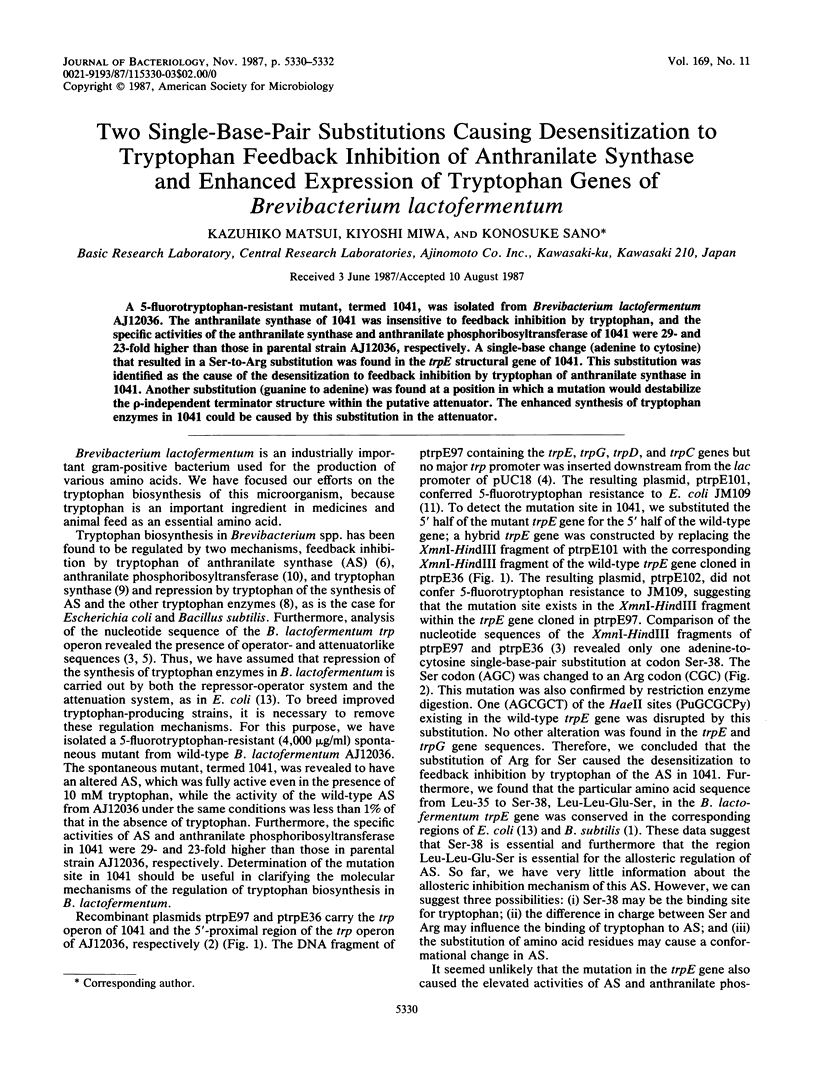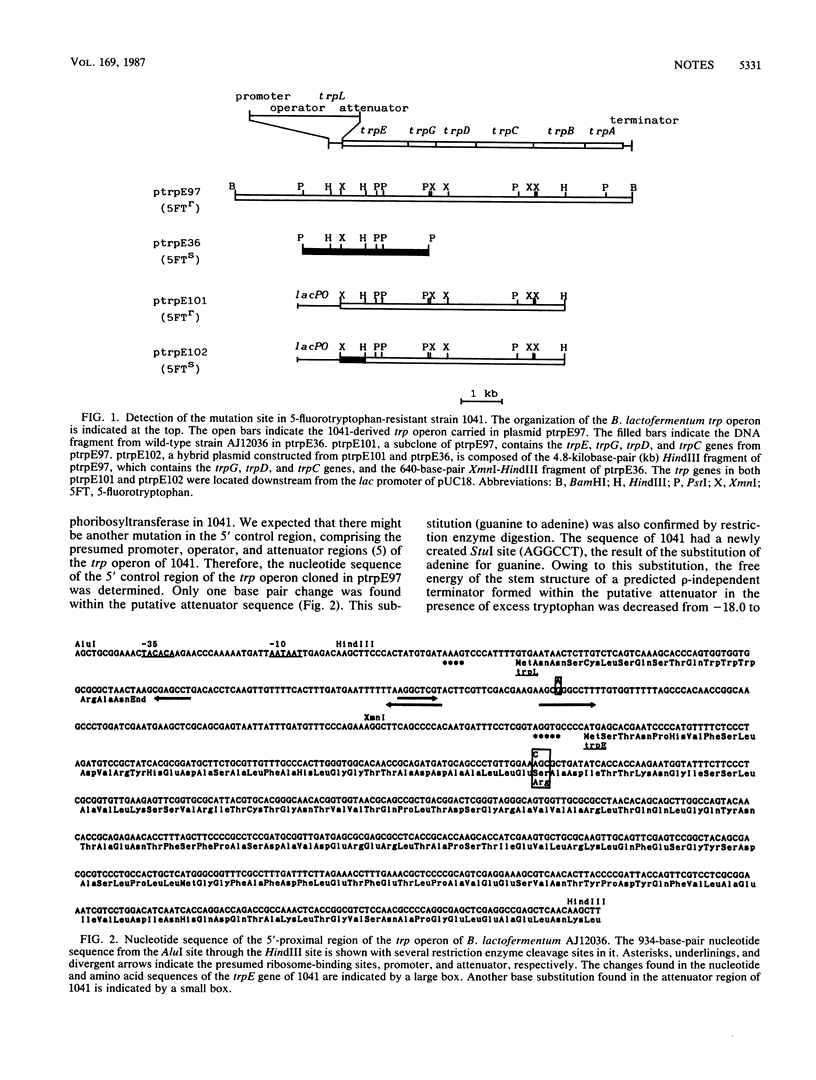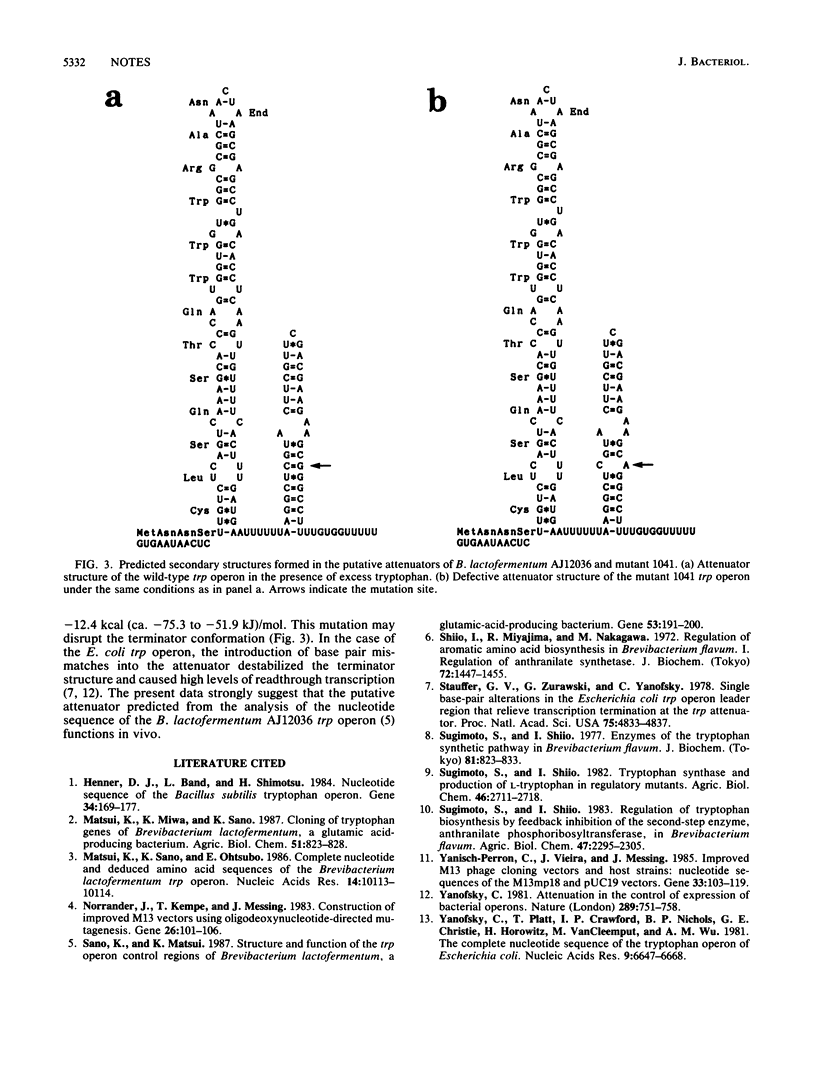Abstract
A 5-fluorotryptophan-resistant mutant, termed 1041, was isolated from Brevibacterium lactofermentum AJ12036. The anthranilate synthase of 1041 was insensitive to feedback inhibition by tryptophan, and the specific activities of the anthranilate synthase and anthranilate phosphoribosyltransferase of 1041 were 29- and 23-fold higher than those in parental strain AJ12036, respectively. A single-base change (adenine to cytosine) that resulted in a Ser-to-Arg substitution was found in the trpE structural gene of 1041. This substitution was identified as the cause of the desensitization to feedback inhibition by tryptophan of anthranilate synthase in 1041. Another substitution (guanine to adenine) was found at a position in which a mutation would destabilize the rho-independent terminator structure within the putative attenuator. The enhanced synthesis of tryptophan enzymes in 1041 could be caused by this substitution in the attenuator.
Full text
PDF


Selected References
These references are in PubMed. This may not be the complete list of references from this article.
- Henner D. J., Band L., Shimotsu H. Nucleotide sequence of the Bacillus subtilis tryptophan operon. Gene. 1985;34(2-3):169–177. doi: 10.1016/0378-1119(85)90125-8. [DOI] [PubMed] [Google Scholar]
- Matsui K., Sano K., Ohtsubo E. Complete nucleotide and deduced amino acid sequences of the Brevibacterium lactofermentum tryptophan operon. Nucleic Acids Res. 1986 Dec 22;14(24):10113–10114. doi: 10.1093/nar/14.24.10113. [DOI] [PMC free article] [PubMed] [Google Scholar]
- Norrander J., Kempe T., Messing J. Construction of improved M13 vectors using oligodeoxynucleotide-directed mutagenesis. Gene. 1983 Dec;26(1):101–106. doi: 10.1016/0378-1119(83)90040-9. [DOI] [PubMed] [Google Scholar]
- Sano K., Matsui K. Structure and function of the trp operon control regions of Brevibacterium lactofermentum, a glutamic-acid-producing bacterium. Gene. 1987;53(2-3):191–200. doi: 10.1016/0378-1119(87)90007-2. [DOI] [PubMed] [Google Scholar]
- Shiio I., Miyajima R., Nakagawa M. Regulation of aromatic amino acid biosynthesis in Brevibacterium flavum. I. Regulation of anthranilate synthetase. J Biochem. 1972 Dec;72(6):1447–1455. doi: 10.1093/oxfordjournals.jbchem.a130037. [DOI] [PubMed] [Google Scholar]
- Stauffer G. V., Zurawski G., Yanofsky C. Single base-pair alterations in the Escherichia coli trp operon leader region that relieve transcription termination at the trp attenuator. Proc Natl Acad Sci U S A. 1978 Oct;75(10):4833–4837. doi: 10.1073/pnas.75.10.4833. [DOI] [PMC free article] [PubMed] [Google Scholar]
- Sugimoto S., Shiio I. Enzymes of the tryptophan synthetic pathway in Brevibacterium flavum. J Biochem. 1977 Apr;81(4):823–833. doi: 10.1093/oxfordjournals.jbchem.a131546. [DOI] [PubMed] [Google Scholar]
- Yanisch-Perron C., Vieira J., Messing J. Improved M13 phage cloning vectors and host strains: nucleotide sequences of the M13mp18 and pUC19 vectors. Gene. 1985;33(1):103–119. doi: 10.1016/0378-1119(85)90120-9. [DOI] [PubMed] [Google Scholar]
- Yanofsky C. Attenuation in the control of expression of bacterial operons. Nature. 1981 Feb 26;289(5800):751–758. doi: 10.1038/289751a0. [DOI] [PubMed] [Google Scholar]
- Yanofsky C., Platt T., Crawford I. P., Nichols B. P., Christie G. E., Horowitz H., VanCleemput M., Wu A. M. The complete nucleotide sequence of the tryptophan operon of Escherichia coli. Nucleic Acids Res. 1981 Dec 21;9(24):6647–6668. doi: 10.1093/nar/9.24.6647. [DOI] [PMC free article] [PubMed] [Google Scholar]


